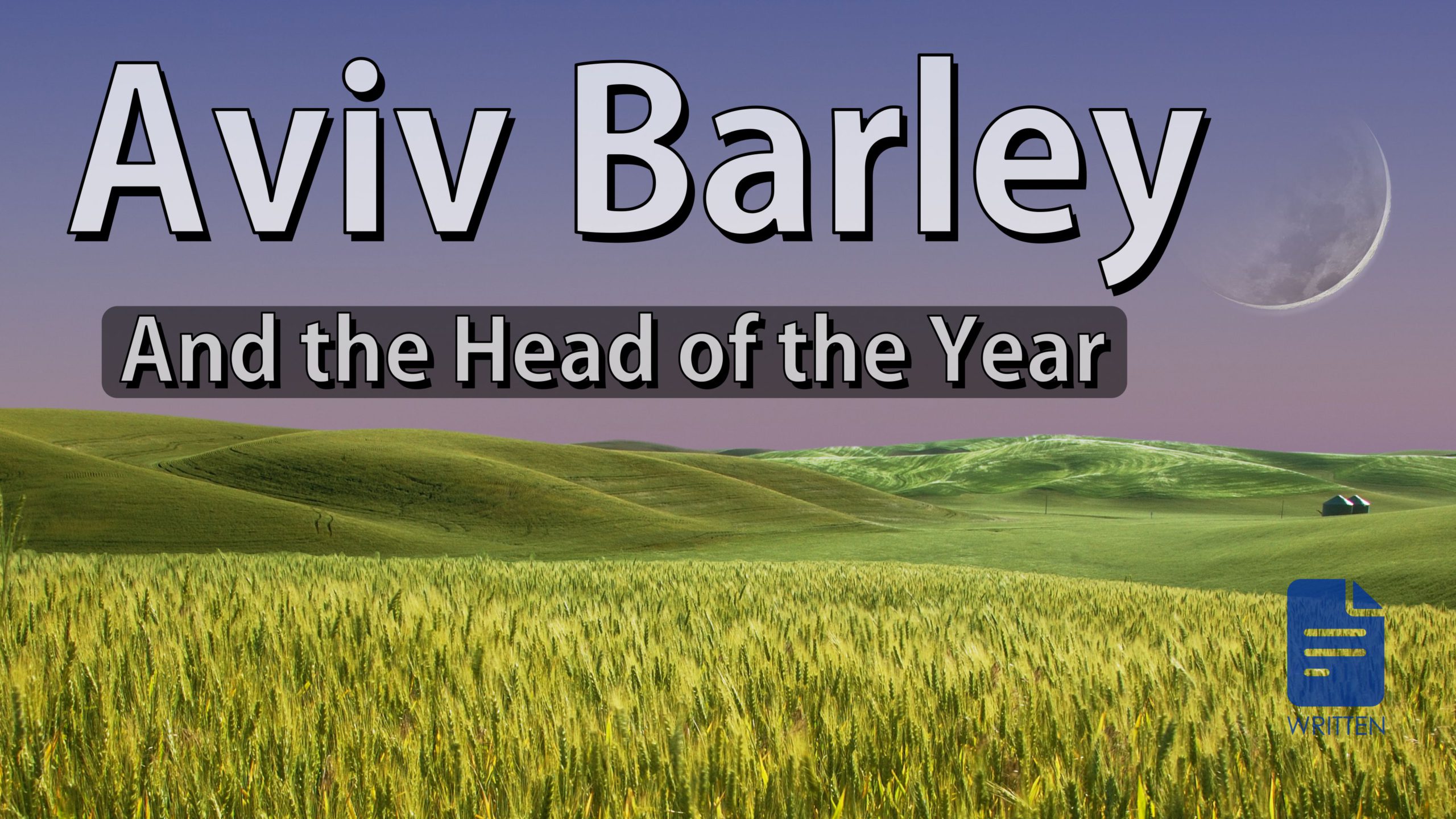
In the last chapter we saw how to determine Rosh Chodesh (the new moon day). In this chapter we will see that there is a special new moon day that also starts the year. This is called Rosh HaShanah, or the Head of the Year.
The timing of Rosh HaShanah is critical, as it establishes the calendar year. If Rosh HaShanah is timed correctly, the rest of the feasts will line up correctly with the other crop harvests. However, if it is timed incorrectly, the rest of the feasts will not line up with the other crop harvests.
As we will see, the timing of Rosh HaShanah is based on the first full sheaf of barley to come ripe in the land of Israel. That is because 15-21 days after we declare Rosh HaShanah, we must cut the very first sheaf of barley firstfruits, and present it to Yahweh on what is called Yom HaNafat HaOmer (the Day of the Wave Sheaf Offering). Further, the omer of barley needs to be in one of two special states, called aviv and carmel (and we will define these terms later in this chapter). This is critical, because barley ripens very rapidly, and once it is ripe it does not stay in the head very long (but falls to the ground). If we make a mistake and declare Rosh HaShanah too early, the barley will not yet have reached the aviv or carmel states. However, the much bigger danger is to wait too long and declare Rosh HaShanah too late (and many people make this error). However, if we do that, then the firstfruits of barley will drop to the ground before we can present them to Yahweh (and while there may be other barley we can present, it will not be the firstfruits). This also means that the farmers with the earliest ripening barley will not be able to harvest their crops on time (so they will lose their crops, and be financially ruined). These errors are avoidable.
Determining Rosh Hashanah probably seems simple to barley farmers, because they are in tune with the land and the growth-cycles of barley. All one really has to do is to wait until the new moon, and ask the barley farmers if their crop will be aviv or carmel 15-21 days after the new moon (and again, we will define these terms later). If the barley farmers say, “Yes, the barley will be aviv or carmel 15-21 days after the new moon”, then we should declare that new moon to also be the new year (Rosh HaShanah). But if the barley farmers say, “No, the barley will not be either aviv or carmel 15-21 days after the new moon”, then we have to wait another month. It really is that simple, but we will explain the process in detail, so that anyone who wants to understand what Yahweh’s Torah commands can understand it.
Another reason to study the commands is that some people want to determine the Head of the Year based on other factors (besides the aviv barley). Some say the barley cannot be aviv until the Spring Equinox (or Equilux) has passed, even though it often happens, and even though the word equinox does not exist in Scripture (and neither does the concept). Others say we need to have “harvestable fields” of barley before we can declare the new year, even though it means we will not offer the true firstfruits of barley. These kinds of errors occur when we add things to Yahweh’s word, or use one verse to explain away another.
About Rosh HaShanah and the Barley
Before we begin, we should note that the Orthodox Jewish Hillel II calendar puts Rosh HaShanah at the beginning of the seventh month. However, in marked contrast, Yahweh places it in the first month, with the ripening of the barley.
During the first Exodus, in Exodus 9:31-32, Yahweh struck Egypt with a plague of hail. The hail struck the flax because it was budding, while the barley was in the head (which is a more advanced condition). In Hebrew, the term for “in the head” is aviv (אָבִיב).
Shemote (Exodus) 9:31-32
31 Now the flax and the barley were struck, for the barley was in the head [אָבִיב, aviv] and the flax was in bud.
32 But the wheat and the spelt were not struck, for they are late crops.
The term aviv (אָבִיב) is Strong’s Concordance OT:24, and it refers to tender, green, young grain.
OT:24 ‘abiyb (aw-beeb’); from an unused root (meaning to be tender); green, i.e. a young ear of grain; hence, the name of the month Abib or Nisan:
Not long after the barley was aviv, Yahweh told Moshe and Aharon that this was to be the first month of their year.
Shemote (Exodus) 12:2
2 “This month is the head of months for you; it is the first month of the year to you.”
What this tells us is that when the barley grains are tender, green, and young, that is the first month of the year. But to understand what to do with that information, let us take a closer look at how barley develops.
How Barley Develops
Modern agriculture uses a fairly complex method of analyzing cereal grains, called the Zadoks Scale. Many times people want to use the Zadoks Scale to determine the aviv barley, perhaps because it is scientific, and perhaps because the word Zadoks sounds like tzaddik, which is the Hebrew word for a righteous man. However, the Zadoks Scale did not exist in ancient times, so we do not use it (as it only confuses the issue).
For our purposes, barley and other cereal grains can be thought to pass through various stages of growth. These stages start out slowly, and gain speed as the barley nears maturity. It may be helpful to imagine a barley plant passing through these phases.
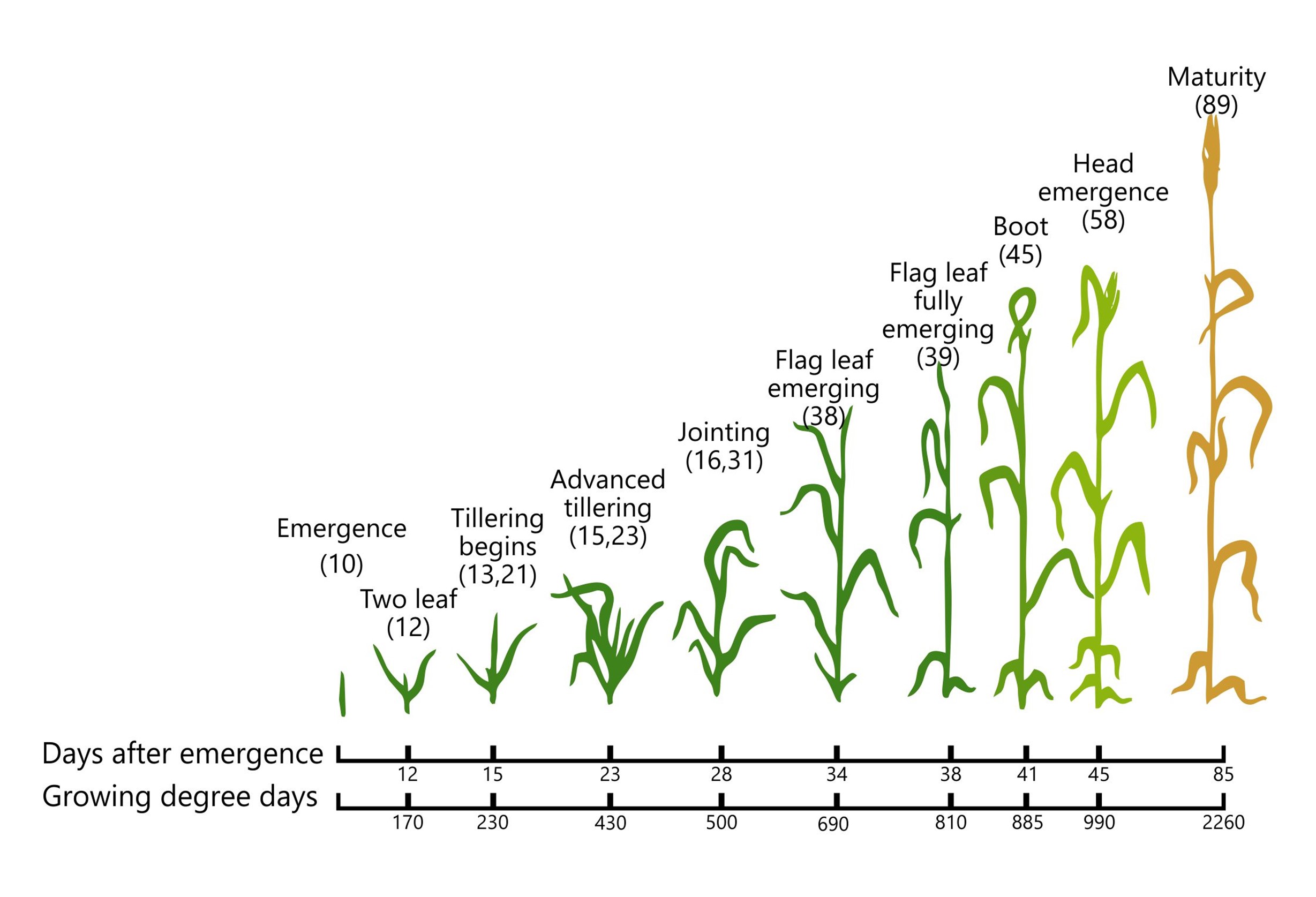
The above graphic is by the University of Wisconsin, USA, from their Spring Barley Growth and Development Guide. It shows the development of average modern spring barley in Wisconsin, USA. It is important to bear in mind that not only is the weather in Israel different than the weather in Wisconsin, but that these numbers are only averages. The process takes longer when the weather is cold, and takes less time when the weather is hot. We should also remember that there is really no such thing as an “average” crop—but that each year the weather is different, and that each field is different. However, with that in mind, we can see some important patterns.
The most important thing for us to see here is that in an average Wisconsin spring, the seed head emerges from the stalk (or from what is called the boot) about 58 days after germination (or just under two months). Then just 31 days later, it is ready for modern combine harvest. That means from the time the seed head flowers and is pollinated, there is basically only a month until the plant is ready for harvesting by modern combine methods. However, there was even less time in ancient times! That is because modern combine harvesting depends on the plant being already old and brittle, and this method does not work with ancient hand sickles.
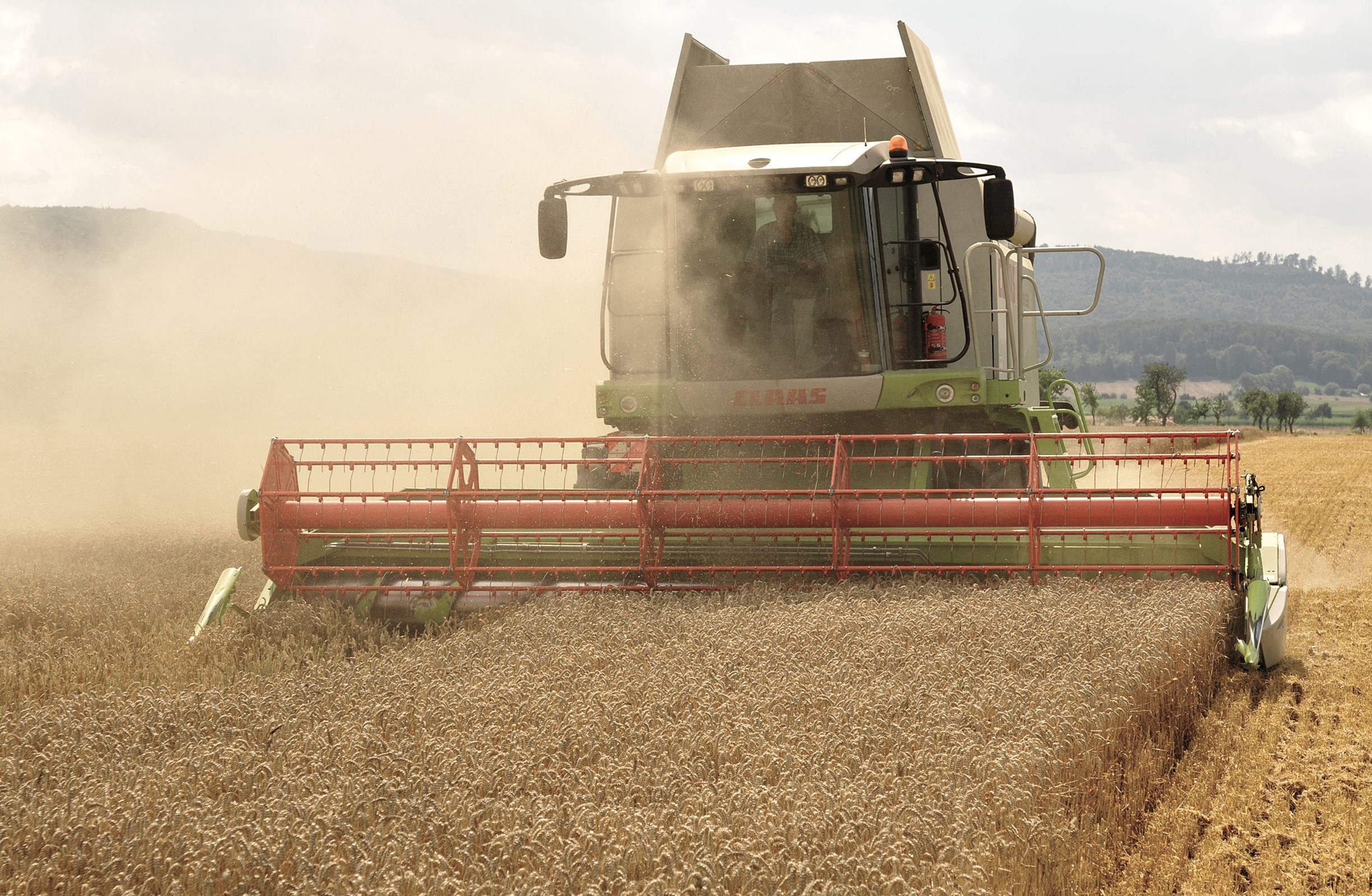
A combine slaps super-ripe, fragile barley with a paddle, knocking everything into a large tray. Because the barley is so brittle, the seed head shatters, and the grain is also largely separated from the chaff. The combine then performs a combination of operations (which is why it is called a combine). These include separating the seed from the chaff.
However, in ancient times, harvesting had to be done by hand sickles (which were not nearly as sharp as modern steel sickles). Ancient sickles were typically made either of flint or sharpened animal bones mounted in wood. For example, this is an ancient flint sickle found in the land of Israel.

Here is an ancient sickle made with animal bones, found in the Middle East.

When barley is golden brown it is too fragile to harvest by hand sickle. One has to harvest the barley much earlier when harvesting by hand, so that the crop will not be lost. As we will see, the ideal is to harvest the crop just as the plant is starting to turn from green to yellow. One cannot wait until the plant is already brown and brittle, or the shock of harvesting will shatter the seed heads, and much of the crop will fall to the ground, which results either in financial disaster or even starvation for the farmers. This must be avoided.
Stages of Barley Growth
If we look at this chart again, we can see that barley passes through several stages of growth.
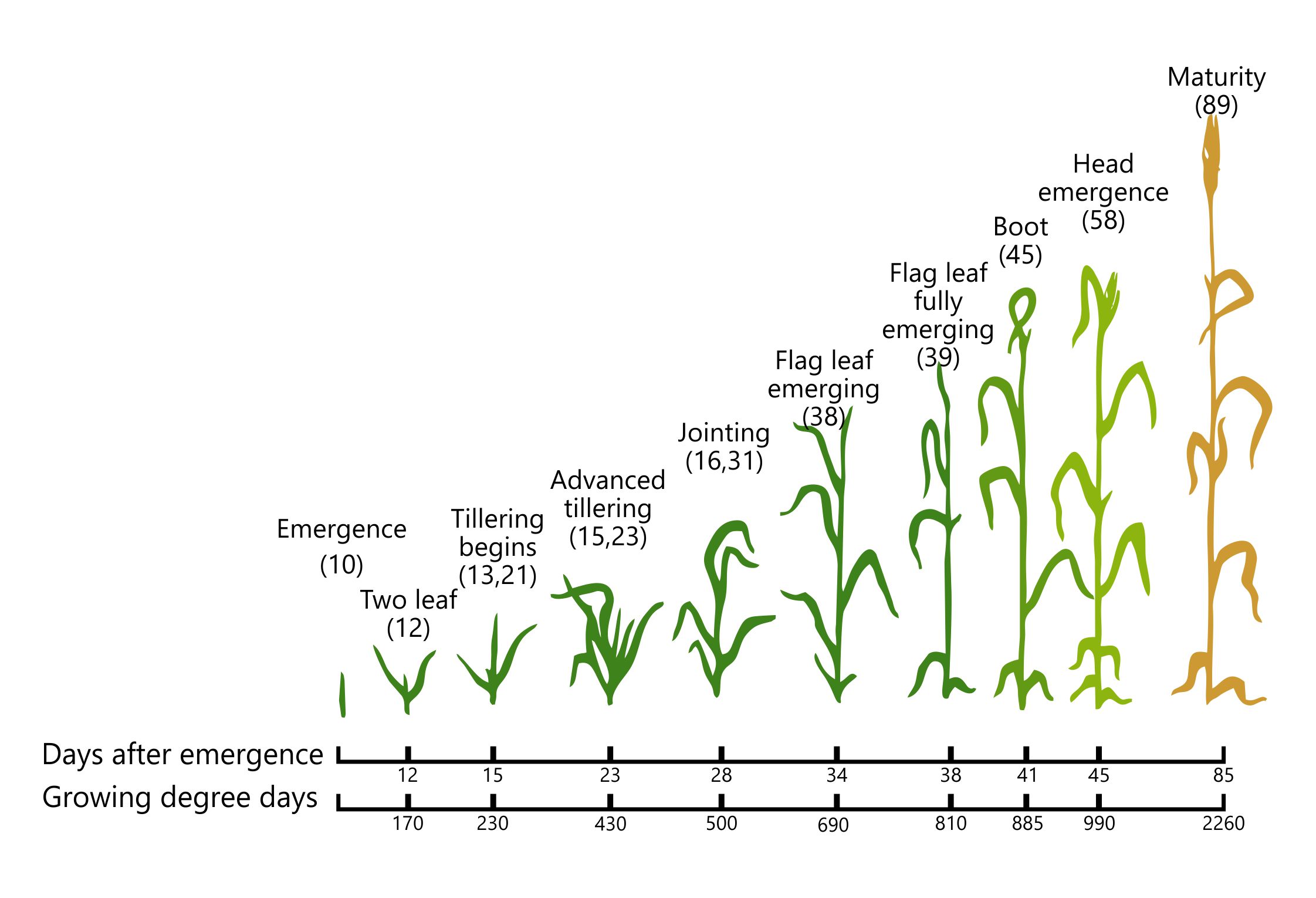
The first stage is called the vegetative growth stage. During vegetative grown, the barley plant is soft, and flexible. It can get hit by hail and it bounces right back. This is why the wheat and the spelt were not destroyed by the hail in Exodus 9:32, is that they were still in the vegetative growth stage, and so they were still soft and flexible (and thus they were able to withstand the impact of hail without sustaining any damage).
After the vegetative growth stage, the head emerges from the boot (i.e., the stalk), and the plant then buds and flowers. This is called the budding and flowering stage. During this stage, the plant stalks start to become rigid, as they are preparing to bear the weight of the head. They also get top-heavy. If cereal grasses get hit by hail or a hard rain at this point, the weight of the wet head pulls the plant over, and the stalks can kink, causing the crop to be damaged or lost. This is why the flax and barley were destroyed in Exodus 9:31, is that the flax was flowering, and the barley was aviv (which we shall see is medium dough). Because of this, the plants were now top-heavy, and their stalks were no longer flexible. Thus, they could be destroyed by hail (or even a heavy rain).
(Some teach that the barley has to be already brittle and dry for the crop to be damaged by hail. This is incorrect, as the flax was still damaged even though it was only in bud. Rather, what makes grains susceptible to hail is that they are top-heavy, and the stalks are brittle.)
 After the plant has flowered and is pollinated, the seed pod is formed. If you tear open the seed pod, the closed flower will look something like cotton. This is called the cotton stage. Next the plant will start to pump fluid into the seed pod. If you tear it open, you will see watery-looking fluid. This is called the water stage.
After the plant has flowered and is pollinated, the seed pod is formed. If you tear open the seed pod, the closed flower will look something like cotton. This is called the cotton stage. Next the plant will start to pump fluid into the seed pod. If you tear it open, you will see watery-looking fluid. This is called the water stage.
 After that the plant begins pumping starch into the head. At first this makes the liquid look milky. This is called the milk stage. Depending on a variety of factors, this stage is reached approximately 8 days after flowering and fertilization.
After that the plant begins pumping starch into the head. At first this makes the liquid look milky. This is called the milk stage. Depending on a variety of factors, this stage is reached approximately 8 days after flowering and fertilization.
Approximately 10-11 days after fertilization the plant has now pumped enough starch into the seed that if one were to open up the seed head, one would see something that looks like a wet, slimy worm. This is often called the worm stage.
 As the plant continues to pump starch into the seed pods, they continue to become fuller, and harder. After about 14 days, if one were to cut the seed pods open, it would resemble soft bread dough inside. This is called the soft dough stage. Such “soft bread dough” is easily cut with the fingernail, but there should be no milky liquid.
As the plant continues to pump starch into the seed pods, they continue to become fuller, and harder. After about 14 days, if one were to cut the seed pods open, it would resemble soft bread dough inside. This is called the soft dough stage. Such “soft bread dough” is easily cut with the fingernail, but there should be no milky liquid.
At approximately 17-18 days, the seed heads are now filled with starch. At this point, the grains will not gain any more mass, but merely dry out, and lose moisture. The plant also starts to change color from green to yellow, indicating that the plant is starting to die, and dry up. This is called the medium dough stage, and as we will see, this is what qualifies as aviv barley.
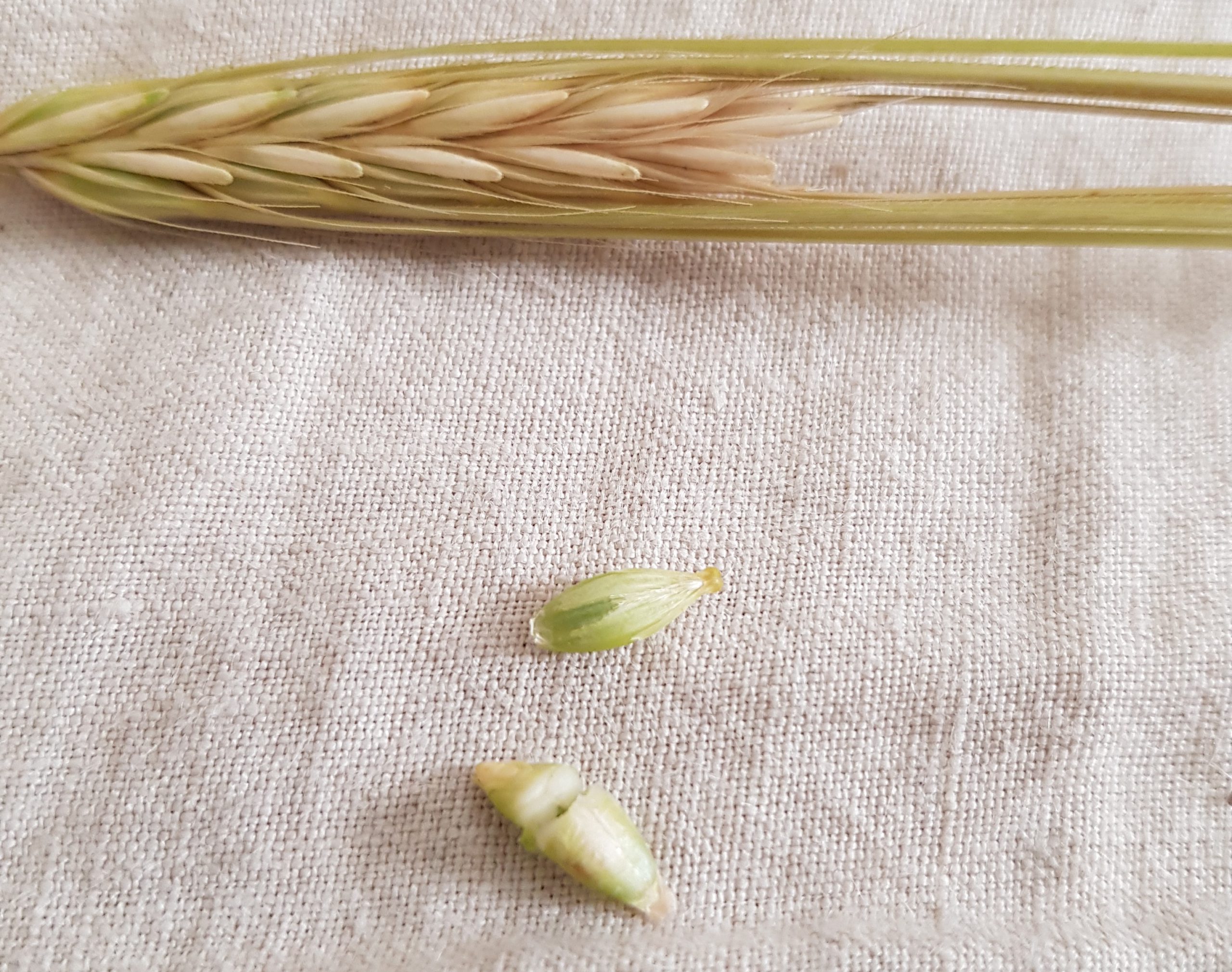
Although medium dough barley is fully formed, it is still greenish. This agrees with the Strong’s definition of aviv, which says that the grain will be tender, green, and young.
OT:24 ‘abiyb (aw-beeb’); from an unused root (meaning to be tender); green, i.e. a young ear of grain; hence, the name of the month Abib or Nisan:
Medium dough grain should have the consistency of medium-hard bread dough. One should be able to cut it with the fingernail, but it should not be watery inside (at all). Notice how these grains are just starting to turn yellow—but more importantly, notice the texture inside. This is the ideal stage for harvesting with a hand sickle because the grains have as much mass as they are going to have, but the likelihood of shattering is not yet very great. That is to say that if a farmer harvests during the medium dough (aviv) stage, he may have to dry the grains before threshing, but he will not likely lose much of his crop. Only, this condition does not last very long.
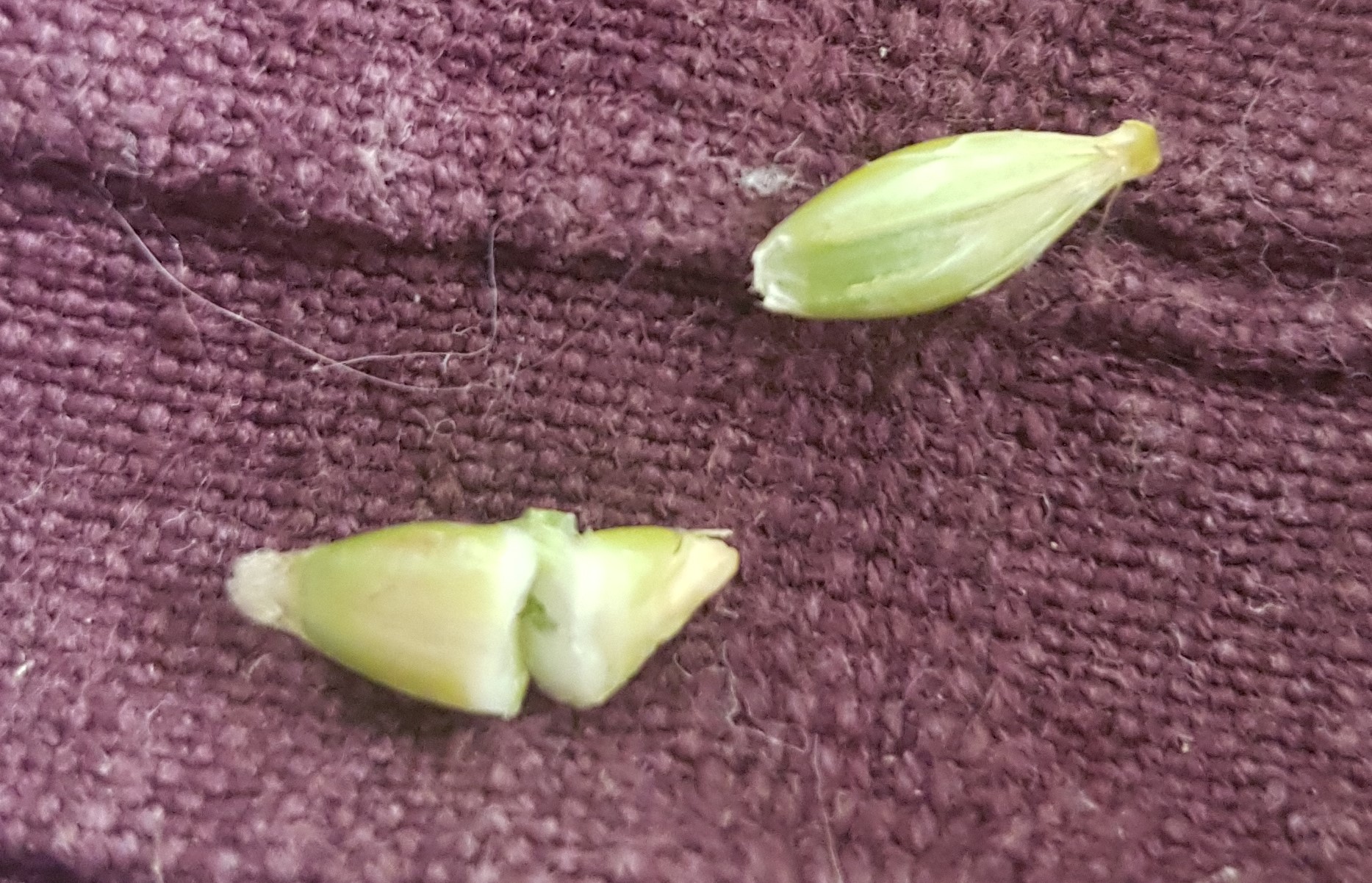
Here is a field where the barley plants have just started to turn yellow. This indicates that the seed is finished growing, and so now the plants can die, and drop their seed (and reproduce). This yellowing is a good indicator that it is time to inspect the grain heads, to see if they are medium dough. A good example of this is the yellow patch of barley in the foreground, which was found in the Galilee region in Israel on February 6th, 2021 CE.

We will explain why medium dough barley is aviv in a moment, but first let us finish talking about the stages of barley development.
 At about 21 days (three weeks), the grains have reached a point where the consistency of the barley grain resembles hard bread dough. One can still cut it with a fingernail, but it takes effort, as it has a leathery consistency. This is called the hard dough stage, and it is about the latest a farmer wants to harvest his crops with a hand sickle, lest the heads shatter and drop their seeds during the harvesting process. This is only a few days after medium dough, which is why Yeshua tells us that when the grain is ripe, the wise farmer immediately puts in his sickle, because the harvest has come.
At about 21 days (three weeks), the grains have reached a point where the consistency of the barley grain resembles hard bread dough. One can still cut it with a fingernail, but it takes effort, as it has a leathery consistency. This is called the hard dough stage, and it is about the latest a farmer wants to harvest his crops with a hand sickle, lest the heads shatter and drop their seeds during the harvesting process. This is only a few days after medium dough, which is why Yeshua tells us that when the grain is ripe, the wise farmer immediately puts in his sickle, because the harvest has come.
Marqaus (Mark) 4:28-29
28 “For the earth yields crops by itself: first the blade, then the head, after that the full grain in the head.
29 But when the grain ripens, immediately he puts in the sickle, because the harvest has come.”
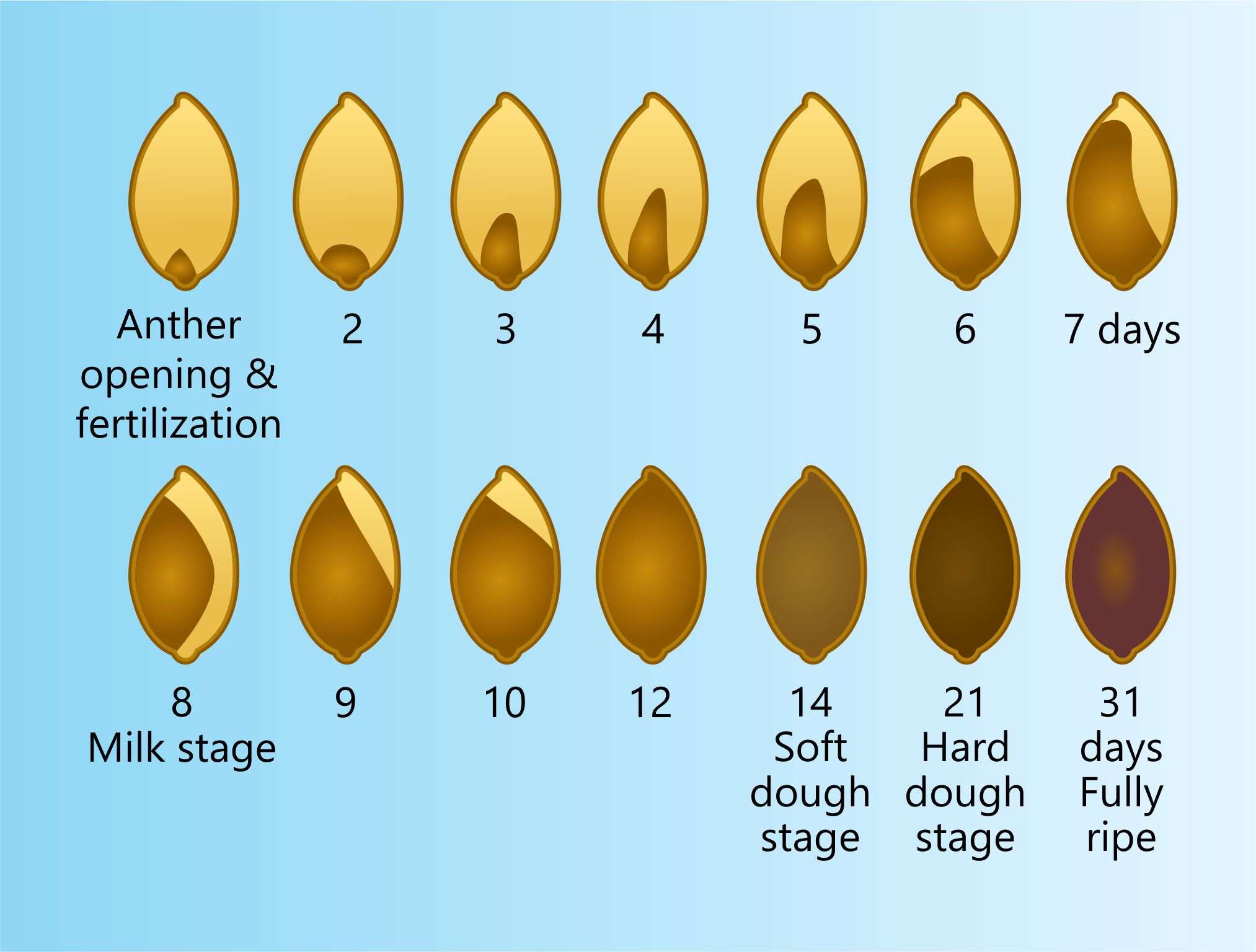
As the barley continues to harden and lose moisture, it enters what is called the very hard dough stage. In this stage it is still possible to dent the grain with a fingernail, but it is not possible to cut it with the fingernail. Very hard dough is already too brittle for ancient sickle harvesting. If one tries to harvest with an ancient hand sickle at the very hard dough stage, a lot of the heads will shatter, and the barley will be lost.
Finally, at about 31 days (or a month) after the barley is pollinated, the barley plant is ripe for harvesting with a modern combine. As we mentioned earlier, this is much too ripe for harvesting with a sickle. If one tries to harvest with an ancient hand sickle at this point, a very large percentage (if not most) of the crop will be lost.
What, then? As we will see, this points to a need to offer the very first sheaf of aviv or carmel barley to Yahweh, to clear the way for the rest of the harvest.
Bringing the Very Firstfruits of Aviv or Carmel
Leviticus 2:14 tells us that we are to bring an offering of the firstfruits (בִּכּוּרִים) of our barley to Yahweh.
Vayiqra (Leviticus) 2:14-15
14 “Also when you bring an offering of firstfruits [בִּכּוּרִים] to Yahweh, you shall bring green heads of grain [אָבִיב קָלוּי] parched in the fire, [and/or] crushed carmel [גֶּרֶשׂ כַּרְמֶל] shall you offer for your firstfruits offering.
15 And you shall put oil on it, and lay frankincense on it. It is a grain offering.”
The term firstfruits (בִּכּוּרִים) is Strong’s Old Testament OT:1061, meaning the very first of the fruits. It could not be simpler, but others often miss (or ignore) this most basic of requirements.
OT:1061 bikkuwr (bik-koor’); from OT:1069; the first-fruits of the crop:
KJV – first fruit (-ripe [figuratively]), hasty fruit.
When we look up the root word at OT:1069, we see that it refers to the fruit that is truly first (as if “bursting the womb.”) Why can these other groups not grasp the idea that this calls for the very first of the barley fruits?
OT:1069 bakar (baw-kar’); a primitive root; properly, to burst the womb, i.e. (causatively) bear or make early fruit (of woman or tree); also (as denominative from OT:1061) to give the birthright:
KJV – make firstborn, be firstling, bring forth first child (new fruit).
And not only must it be the very first of the barley fruits, but it must also be in a special state of either aviv (אָבִיב), or carmel (כַּרְמֶל). These are the only two conditions in which Yahweh will accept our barley firstfruits. So, let’s see what these two terms mean.
Aviv: Medium Dough
As we already saw, Strong’s Concordance defines aviv as tender, green, and young grain.
OT:24 ‘abiyb (aw-beeb’); from an unused root (meaning to be tender); green, i.e. a young ear of grain; hence, the name of the month Abib or Nisan:
The term kalui (קָלוּי) means roasted, so aviv kalui refers to roasted young ears of grain. Medium dough works because although the grain is moist, it has a full starch content. Thus, when it is roasted on the fire, the moisture is driven out, and the toasted grains can be ground into flour. Grinding into flour fulfills the requirement in Leviticus 2:15, that we lay oil and frankincense on the firstfruits offering (i.e., by making cakes).
15-21 Days from the New Year to an Omer of Aviv
Now let us look at the requirement to offer the omer in Leviticus 23:10-11, and also verse 14. This tells us that Yom HaNafat HaOmer (the Day of the Wave Sheaf Offering) is to take place on the day after the weekly Sabbath in which the Passover falls. It also tells us that we are not allowed to eat any part of the new crop until after we have brought our firstfruits.
Vayiqra (Leviticus) 23:10-11, 14
10 “Speak to the children of Israel, and say to them: ‘When you come into the land which I give to you, and reap its harvest, then you shall bring a sheaf of the firstfruits of your harvest to the priest.
11 He shall wave the sheaf before Yahweh, to be accepted on your behalf; on the day after the [weekly] Sabbath the priest shall wave it…”
14 “You shall eat neither bread nor parched grain nor fresh grain until the same day that you have brought an offering to your Elohim; it shall be a statute forever throughout your generations in all your dwellings.”
For example, in 2021, the new moon of Rosh HaShanah fell on the first day of the week. Fourteen days later, the Passover was held on Shabbat, and then Yom HaNafat HaOmer was the very next day. That means that none of the current year’s crop could be eaten until the day after the Passover (which is also what happened in Joshua 5:10-11). Thus there were 15 days in between Rosh HaShanah and Yom HaNafat HaOmer.
| Rosh | 2 | 3 | 4 | 5 | 6 | 7 |
| 8 | 9 | 10 | 11 | 12 | 13 | Pass |
| Omer |
Alternately, if the new moon is seen on the second day of the week, this pushes the Passover to the first day of the week, and then Yom HaNafat HaOmer is not held until the first day of the following week. In this condition there are 21 days from Rosh HaShanah to Yom HaNafat HaOmer.
| Rosh | 2 | 3 | 4 | 5 | 6 | |
| 7 | 8 | 9 | 10 | 11 | 12 | 13 |
| Pass | 15 | 16 | 17 | 18 | 19 | 20 |
| Omer |
This shows us that there can be anywhere in between 15-21 days between Rosh HaShanah and Yom HaNafat HaOmer. That is why, just before the new moon, we inspect the barley to see if the firstfruits of the new barley crop will be ready to present to Yahweh 15-21 days later.
The Aviv Firstfruits are the First Thing to be Cut
We also need to know that we cannot harvest any part of the new crop before we present the wave sheaf of aviv or carmel barley on Yom HaNafat HaOmer, because Deuteronomy 16:9 prohibits us from doing so. That is because Deuteronomy 16:9 tells us we need to begin a 50-day Omer Count up to Pentecost (Shavuot) when we begin to put the sickle to the standing grain.
Devarim (Deuteronomy) 16:9-10
9 “You shall count seven weeks for yourself; begin to count the seven weeks from the time you begin to put the sickle to the grain.
10 Then you shall keep the Feast of Weeks to Yahweh your Elohim with the tribute of a freewill offering from your hand, which you shall give as Yahweh your Elohim blesses you.”
Simply put, Deuteronomy 16:9 tells us to begin to count the omer when we begin to cut the firstfruits of the new crop. Or, in other words, when we begin to cut the firstfruits of the new crop, that is when we begin to count the omer up to Shavuot (Pentecost).
“When we begin to cut, that is when we begin to count.”
“When we begin to count, that is when we begin to cut.”
By definition, this means that the very first barley should be cut on Yom HaNafat HaOmer, and given to Yahweh. We may harvest our crops after the barley is presented to Yahweh (but nothing should be harvested before that).
(Sadly, many other teachers look for excuses to explain Deuteronomy 16:9 away. We pray that they will learn that Yahweh disapproves of that before the judgment.)
The Omer Aviv Firstfruits Symbolize Yeshua
We know that everything in the Tanach points to Yeshua. For example, Yeshua was offered as the first of the firstfruits among those who will be resurrected from the dead.
Qorintim Aleph (1 Corinthians) 15:20-23
20 But now Messiah is risen from the dead,
and has become the firstfruits of those who have fallen asleep.
21 For since by man came death, by Man also came the resurrection of the dead.
22 For as in Adam all die, even so in Messiah all shall be made alive.
23 But each one in his own order: [first] Messiah the firstfruits, [and then] afterward those who are Messiah’s at His coming.
The basic pattern here is that first we present the first of our firstfruits to Elohim in the omer offering, and then we can harvest our crops. The Jewish historian Josephus tells us that this was also the way it was done in the first century. Speaking of the Wave Sheaf Offering, he says:
…they offer the first-fruits of their barley, and that in the manner following: They take a handful of the ears, and dry them, then beat them small, and purge the barley from the bran; they then bring one tenth deal to the altar, to God [sic]; and, casting one handful of it upon the fire, they leave the rest for the use of the priest. And after this it is that they may publicly or privately reap their harvest.
[Josephus: Antiquities of the Jews, Book 3, Chapter 10, Verse 5.]
When Josephus tells us that they took only a handful of the ears, that means it was a small sheaf (and not whole fields of barley). The fact that they had to dry the ears tells us that the barley was not brown, but that it was still moist. It had to be dried so that it could be beaten small (i.e., ground into flour), so that oil and frankincense could be put on it (in keeping with Leviticus 2:15). Then after the omer had been offered, the people could reap their harvest.
And there is other symbolism that points to Yeshua and medium dough. For example, medium dough barley is viable as seed. This speaks to the symbolism in Yochanan (John) 12:24, where Yeshua tells us that when a grain of wheat (which is similar to barley) falls into the ground and dies, it produces much grain (i.e., it reproduces itself).
Yochanan (John) 12:24
24 “Most assuredly, I say to you, unless a grain of wheat falls into the ground and dies, it remains alone; but if it dies, it produces much grain.”
Also, when Yeshua “fell into the ground and died”, many of the saints were raised.
Mattityahu (Matthew) 27:52-53
52 and the graves were opened; and many bodies of the saints who had fallen asleep were raised;
53 and coming out of the graves after His resurrection, they went into the set-apart city and appeared to many.
But What is Geres Carmel Barley?
Now that we know what aviv barley is, what does Yahweh mean in Leviticus 2:14, when He says that when we bring an offering of our firstfruits to Him, we should bring him aviv grain parched in the fire [and/or] geres carmel (גֶּרֶשׂ כַּרְמֶל)?
Vayiqra (Leviticus) 2:14-15
14 “Also when you bring an offering of firstfruits [בִּכּוּרִים] to Yahweh, you shall bring green heads of grain [אָבִיב קָלוּי] parched in the fire, [and/or] crushed carmel [גֶּרֶשׂ כַּרְמֶל] shall you offer for your firstfruits offering.
15 And you shall put oil on it, and lay frankincense on it. It is a grain offering.”
If aviv barley is medium dough barley, then we might expect that carmel barley is hard dough, based on the fact that hard dough can be cracked or crushed in a mortar and pestle. Strong’s Concordance tells us that the word beaten is OT:1643, geres (גֶּרֶשׂ). This refers to grain that needs to be husked (i.e., grain that needs to have its husk removed manually.
OT:1643 geres (gheh’-res); from an unused root meaning to husk; a kernel (collectively), i.e. grain:
KJV – beaten corn.
This is related to OT:1644 garash, which refers to driving something out (as when driving grain out of the husk).
OT:1644 garash (gaw-rash’); a primitive root; to drive out from a possession; especially to expatriate or divorce:
KJV – cast up (out), divorced (woman), drive away (forth, out), expel, surely put away, trouble, thrust out.
As we said earlier, barley that is completely dry (as in modern combine ripe) separates easily from the chaff. However, when barley is less ripe than that, the husk must be manually removed (as with a mortar and pestle). This also works with Josephus’ description.
…they offer the first-fruits of their barley, and that in the manner following: They take a handful of the ears, and dry them, then beat them small, and purge the barley from the bran; they then bring one tenth deal to the altar, to God [sic]; and, casting one handful of it upon the fire, they leave the rest for the use of the priest. And after this it is that they may publicly or privately reap their harvest.
[Josephus: Antiquities of the Jews, Book 3, Chapter 10, Verse 5.]
However, there is an alternate theory regarding carmel barley that also seems to work, and is very intriguing. However, in order to understand it, first we need to talk more about the maturation process of barley, and also look at the case history of the aviv barley in 2021 CE.
Case History of the Aviv Barley in 2021 CE
There was a lot of extreme weather in Israel in late 2020 and early 2021. In late 2020 there was a lot of rain in Israel, and then in December of 2020 and January of 2021 there were six weeks of unseasonably warm weather. Because of this warm weather, the barley began to ripen, and some of it flowered. Then it got cold again. The barley which had not already flowered pulled back, while the barley that had already committed itself by flowering and pollination pushed ahead to make seed. This resulted in a first flush of (early) barley, and a second flush of (later) barley.
As we saw earlier, on 06 February 2021, a believing sister in Yeshua named Becca Biderman found aviv barley in the land of Israel. This was a week ahead of the new moon of 13 February. Thus, the new moon of 13 February was also Rosh HaShanah.
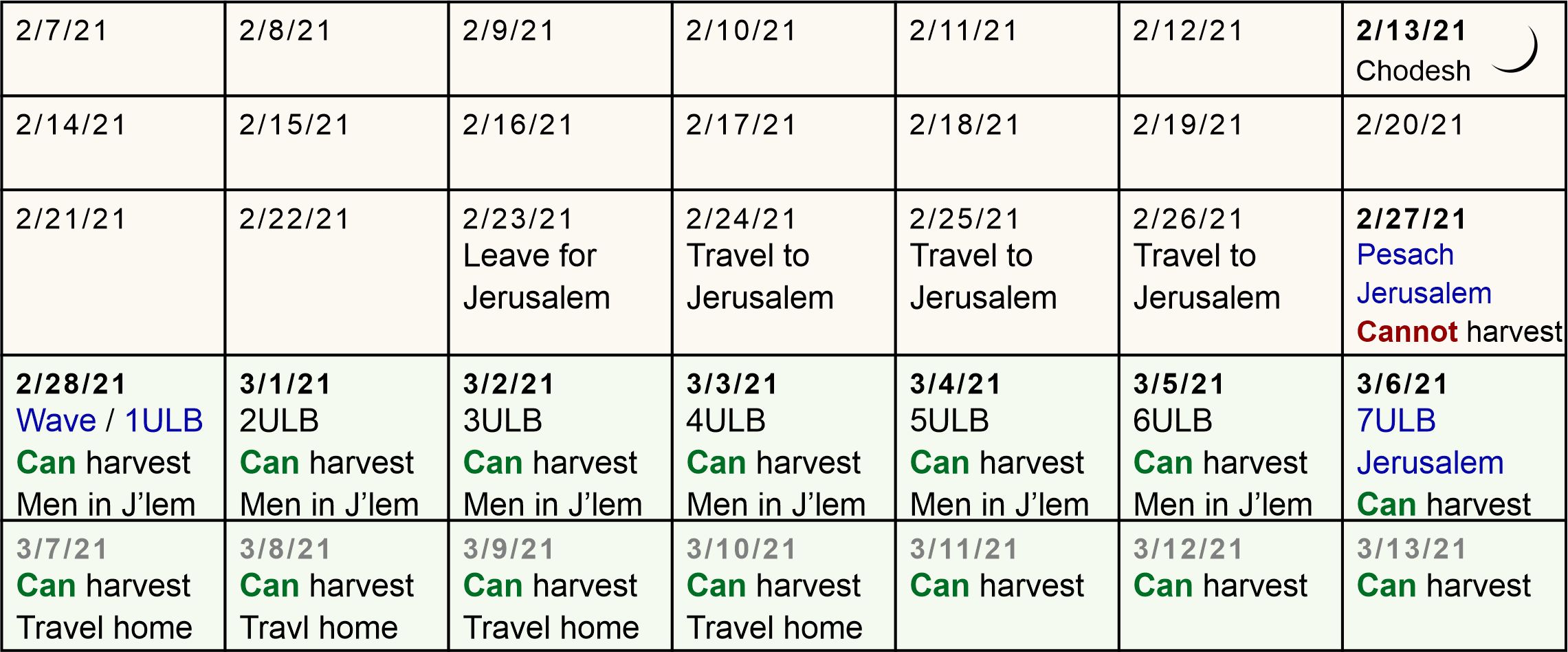
The Passover was therefore 27 February, and Yom HaNafat HaOmer was 28 February. There was no way that the barley would stay in the head for two more months until the next potential Wave Sheaf Offering date (on 04 April 2021), so Yom HaNafat HaOmer had to be on 28 February 2021 (even though it was three weeks ahead of the Spring Equinox).
It is actually not uncommon to see the barley come aviv before the Spring Equinox (and in fact the barley was aviv before the Equinox in the spring of 2020 as well). However, what was so remarkable about 2021 was that some of the barley seemed to be striped purple.
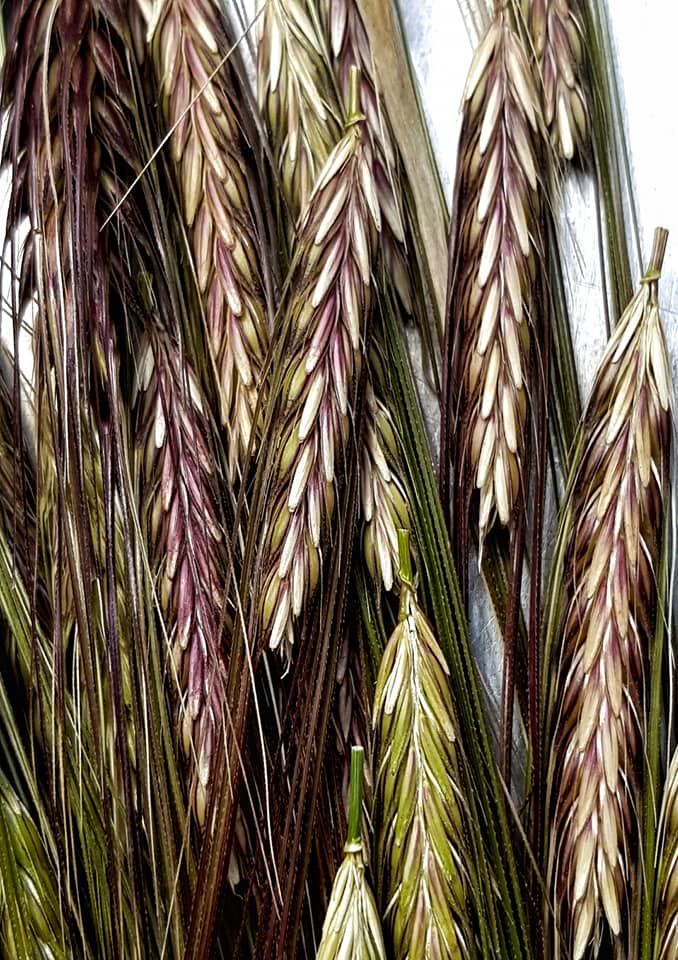
When barley is exposed to extreme climactic stress, it can change color. The change in color is caused by the barley generating anthocyanins. (Cyan means blue.) Anthocyanins are secondary plant metabolites which help the plants to adapt to extreme environments. That is, they help the plants to adapt. Current research indicates that anthocyanins are potentially beneficial to human health. Now, can we imagine the parallels with Yeshua?
Sister Becca Biderman suggested that this was carmel (or karmel) barley, based on the fact that the Hebrew word for a vineyard is kerem (כרם), and the word for carmel seems to have the same root (כַּרְמֶל). Kerem is associated with wine and wine colors, and these anthocyanins appear when the barley is exposed to extreme stresses (just as Yeshua was exposed to extreme stress). If this understanding is correct, then the following verses would seem to speak of Yeshua as being symbolized by the striped, wine-colored barley as well.
B’reisheet (Genesis) 49:10-11
10 The scepter shall not depart from Judah, Nor a lawgiver from between his feet, Until Shiloh [Messiah] comes; And to Him shall be the obedience of the people.
11 Binding his donkey to the vine, And his donkey’s colt to the choice vine, He washed his garments in wine, And his clothes in the blood of grapes.
And:
Yeshayahu (Isaiah) 53:4-5
4 Surely He has borne our griefs And carried our sorrows; Yet we esteemed Him stricken, Smitten by Elohim, and afflicted.
5 But He was wounded for our transgressions, He was bruised for our iniquities; The chastisement for our peace was upon Him, And by His stripes we are healed.
And:
Luqa (Luke) 22:20
20 Likewise He also took the cup after supper, saying, “This cup is the new covenant in My blood, which is shed for you.”
But no matter whether carmel means hard dough barley or wine colored barley, we are to bring him the very first sheaf of our firstfruits of barley when they are aviv or carmel, 15-21 days after Rosh HaShanah.